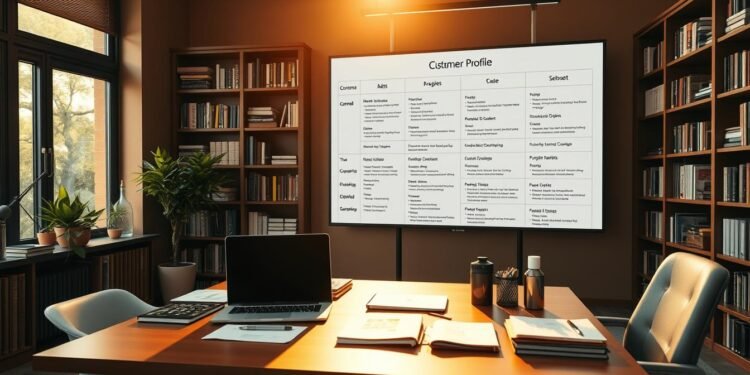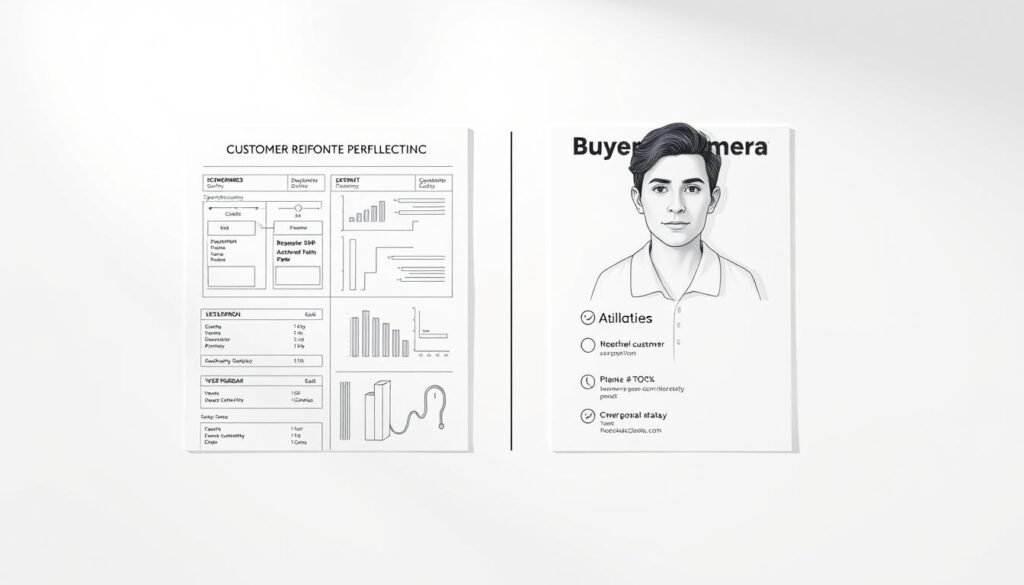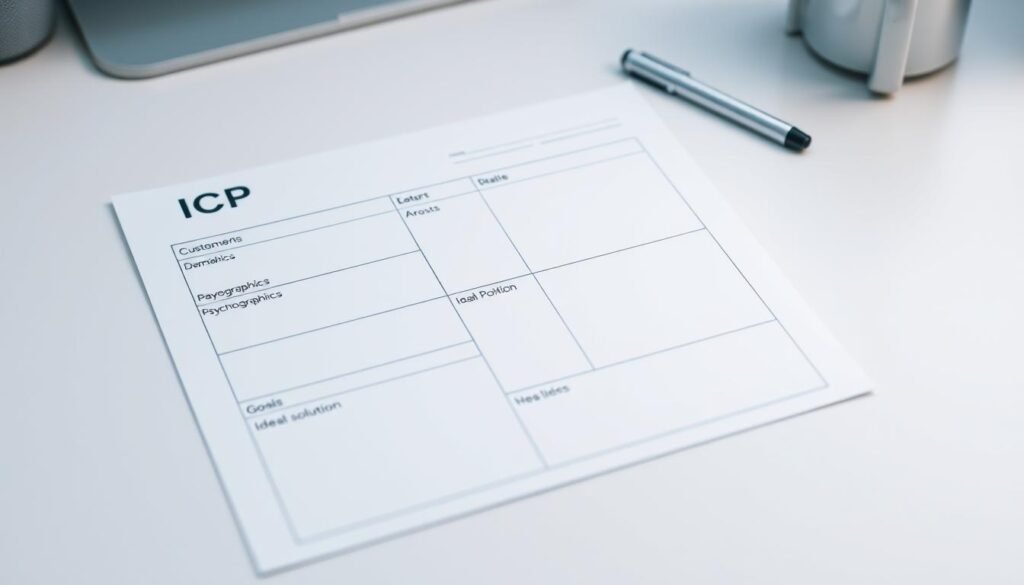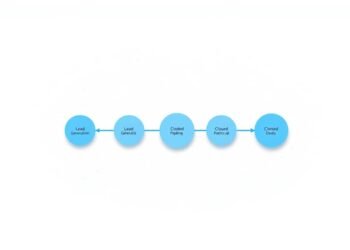Ever wonder why some businesses attract high-value clients effortlessly while others struggle with low conversions? The secret lies in understanding the ideal customer profile (ICP)—a strategic blueprint for identifying the best-fit buyers for your product or service.
An ICP goes beyond basic demographics. It pinpoints companies or individuals with the right budget, needs, and decision-making power. Research shows 86% of buyers prefer brands that align with their goals, proving the power of precise targeting.
For B2B and B2C brands, defining an ICP prevents wasted resources on poor-fit leads. It sharpens marketing campaigns, boosts sales efficiency, and maximizes customer lifetime value. Companies like Qualtrics use ICP-driven strategies to dominate their niches.
Key Takeaways
- An ICP identifies perfect-fit buyers for higher conversions.
- It focuses on profitability, not just broad demographics.
- 86% of buyers prefer solutions tailored to their needs.
- ICP clarity reduces wasted marketing spend.
- It’s foundational for Account-Based Marketing success.
What Is an Ideal Customer Profile (ICP)?
B2B and B2C success starts with decoding the right ICP for your business. This strategic blueprint identifies companies or individuals most likely to buy, retain, and drive revenue—filtering out poor-fit leads.
Defining ICP in B2B and B2C Contexts
In B2B, firmographics rule. A hotel chain’s operational manager needing fleet vehicles exemplifies a precise ICP. Factors like employee count (50–500) or revenue dictate fit.
B2C focuses on individual traits: demographics, purchasing habits, and pain points. A SaaS company targeting mid-sized firms (100–700 employees) avoids pitfalls by excluding freelancers or enterprises.
How ICP Differs from General Target Audiences
Target audiences cast a wide net—like “small businesses.” An ICP zooms in: “California-based logistics firms using Salesforce.” Geographic and legal constraints (e.g., GDPR compliance) further refine it.
Modern ICPs also analyze technographic data. Compatibility with a prospect’s tech stack (like Shopify or HubSpot) ensures smoother onboarding and higher retention.
Why an Ideal Customer Profile Matters
Marketers wasting 50% of their budget on mismatched leads overlook one game-changing tool: the ICP framework. Companies using ICPs achieve 208% higher ABM ROI while slashing customer acquisition costs by 67%. This strategic filter ensures every sales and marketing dollar targets accounts with the highest conversion potential.
The Role of ICP in Account-Based Marketing
ABM teams leveraging ICPs see 3x higher campaign performance. Salesforce data shows 28% faster deal closures when reps focus on ICP-qualified accounts. The framework eliminates guesswork by identifying:
- Companies with compatible tech stacks (e.g., HubSpot users)
- Decision-makers facing specific pain points
- Firms demonstrating expansion potential
Unusual Ventures reduced CAC by 67% after implementing ICP scoring. Their customer success team saw 40% fewer support tickets from properly vetted accounts.
How ICPs Improve Sales and Marketing Efficiency
Targeting precision transforms resource allocation. Marketing teams using ICPs report:
- 45% higher email open rates
- 2x webinar attendance from qualified leads
- 30% better ad conversion rates
Sales pipelines become leaner and more predictable. HubSpot found reps saved 15 hours weekly by skipping poor-fit prospecting. NPS scores jump 20+ points when solutions align perfectly with buyer needs.
These measurable gains explain why 78% of high-growth firms now treat ICP development as a core strategy. The framework turns scattered efforts into targeted revenue engines.
Ideal Customer Profile vs. Buyer Persona
While both ICPs and buyer personas shape marketing strategies, they serve distinct purposes in targeting the right audience. An ICP defines the company most likely to benefit from your solution, while a buyer persona represents the individual decision-maker or user.
Key Differences Between ICP and Buyer Personas
A SaaS company might target mid-sized firms (ICP) but craft content for “Jane,” a 35-year-old operations head needing automation (persona). ICPs focus on firmographics like revenue, while personas explore job roles and pain points.
Unusual Ventures’ matrix template shows how these tools intersect. Their ICP identifies high-growth tech firms, while personas guide messaging for specific teams like engineering or sales.
How ICP and Buyer Personas Complement Each Other
Harness and Okta boost conversions by aligning advocacy campaigns with both tools. Testimonials from ICP-matched accounts resonate with persona-driven needs, like security concerns for IT leaders.
Zoom’s healthcare and education growth stems from this synergy. Their ICP targets institutions with remote collaboration solution needs, while personas inform features for teachers and administrators.
Used together, ICPs fuel ABM strategies, and personas tailor content. This dual approach ensures relevance at every funnel stage—from prospecting to retention.
Key Components of an Ideal Customer Profile
Salesforce and Zoom dominate their markets by mastering these ICP components—shouldn’t you? A high-performing ICP combines seven critical attributes, from firmographics to technographics. Here’s how top brands apply them.
Demographic and Firmographic Data
Start with the basics: location, industry, and company size. Salesforce’s Sales Cloud targets firms with 100–1,000+ employees—a precise range that balances needs and resources.
Revenue matters too. ServiceNow clusters prospects by geographic density, focusing on urban hubs where IT budgets exceed $10M. These attributes filter out poor fits early.
Behavioral and Psychographic Insights
What drives your buyers? Zoom identified distributed teams craving HD video as a core pain point. Behavioral data, like purchase frequency, can predict CLV 30% more accurately.
Scoring systems help. Rate prospects on urgency (e.g., “expiring contracts”) and cultural fit. This prioritizes high-intent accounts.
Technographic and Environmental Factors
Does their tech stack align? API integrations fail if prospects use legacy tools. Zoom’s solution requires bandwidth for HD—environmental checks prevent churn.
ServiceNow’s ICP includes compliance needs (e.g., HIPAA). Such factors ensure seamless adoption in regulated markets.
How to Build Your Ideal Customer Profile
Crafting a high-converting client base begins with structured profiling—here’s how top brands do it. This four-step framework transforms scattered data into actionable insights, helping teams focus resources on accounts with the highest lifetime value potential. Companies using this approach see 37% faster sales cycles according to Forrester.
Step 1: Analyze Your Best Existing Customers
Start with your revenue champions. Export CRM data for top 20% clients by profitability. Sales Cloud’s AI identifies patterns like contract sizes and support ticket frequency that predict success.
Look beyond basic demographics. A SaaS company discovered their best customers shared three traits: using Slack, having remote teams, and maintaining 50+ GitHub repos. These technographic signals became key ICP filters.
Step 2: Identify Common Characteristics
Cluster accounts using cohort analysis. Group clients by:
- Expansion patterns (e.g., adding seats quarterly)
- Tech stack compatibility scores
- Response times to feature updates
Startups can benchmark competitors’ win/loss reports. Look for recurring questions in sales calls that reveal underserved segments.
Step 3: Validate with Customer Feedback
Qualtrics’ platform analyzes NPS surveys, support chats, and product usage feedback. One fintech found 68% of loyal customers cited “regulatory compliance ease” as their top reason to buy—now a core ICP criterion.
Conduct win/loss interviews. Ask champions why they chose you and detractors what nearly stopped them. This reveals hidden decision factors.
Step 4: Refine Based on Industry Trends
Map findings to Gartner’s hype cycle. When remote work tools peaked in 2021, Zoom added “distributed IT infrastructure” to its ICP. Track three key time-sensitive signals:
- Emerging compliance requirements
- Shifting budget allocations
- Adoption rates of adjacent technologies
Update your ICP quarterly. Sales teams using dynamic profiles close 22% more deals according to Outreach.io benchmarks.
Ideal Customer Profile Template and Examples
Template-driven targeting boosts conversion rates by 47%—discover the essential components. This section provides a battle-tested framework and real-world applications to help buyers identify perfect-fit accounts. Whether you’re in SaaS or manufacturing, these tools align sales and marketing efforts.
Essential Questions to Include in Your ICP Template
Top-performing teams use this 15-point checklist to qualify accounts:
- Firmographics: What revenue brackets indicate budget readiness? (e.g., $5M-$50M for mid-market SaaS)
- Tech alignment: Does their existing stack integrate with your solution? (Example: Slack for collaboration tools)
- Growth signals: Are they hiring for roles your product supports? (50+ engineering openings = tech expansion)
Asana’s template includes adoption metrics—their best company matches deploy the tool across 70% of teams within 90 days. Regularly update these criteria to reflect market shifts.
Real-World ICP Examples from Successful Companies
Intercom’s communication focus: Targets firms needing real-time support, with 3+ customer-facing departments. Their template prioritizes:
- Daily ticket volume (100+)
- Existing CRM integrations
- CSAT scores below industry average
Zoom’s vertical strategy: Education clients must have:
- 500+ faculty/staff accounts
- Legacy video system contracts expiring
- IT budgets allocated for remote tools
Manufacturing templates differ—Unusual Ventures adds compliance checklists for safety standards. Customize your framework to reflect industry-specific goals.
Using Your ICP for Marketing and Sales Success
Top-performing companies attribute 32% higher conversions to ICP-driven campaigns. By aligning sales and marketing efforts with precise profiling, teams focus resources on high-potential leads. Salesforce’s data shows this approach improves lead qualification by 32%, proving its impact.
How Sales Teams Can Leverage ICPs
Reps save 15+ hours weekly by filtering poor-fit prospects early. Customize outreach using ICP attributes like:
- Technographics: Target accounts using complementary tools (e.g., HubSpot users for CRM upsells).
- Urgency signals: Prioritize companies with expiring contracts or hiring spikes.
Drift’s conversational AI scripts questions based on ICP pain points, boosting reply rates by 40%.
Tailoring Marketing Campaigns to Your ICP
HubSpot’s pillar-page strategy clusters content by ICP segments. For example, mid-market SaaS firms see case studies highlighting ROI calculators.
ABM ads perform 30% better when targeting:
- Job titles from buyer personas (e.g., “IT Directors”).
- Firmographics like employee count or funding rounds.
CLV models further refine budgets, ensuring campaigns drive long-term value.
Common Mistakes to Avoid When Creating an ICP
Many businesses undermine their own growth by repeating predictable ICP mistakes—here’s how to avoid them. A shocking 73% of companies use outdated profiles, wasting resources on poor-fit leads. These errors distort market positioning and inflate acquisition costs by up to 40%.
Overgeneralizing Your Target Audience
Startups often bloat features trying to serve too many segments. One SaaS company added 17 niche tools, only to find 82% of users needed just three core features. This misalignment creates pain points for both buyers and support teams.
Ignoring Data in Favor of Assumptions
Sales teams relying on gut checks pay 35% higher CAC. A fintech lost $1.2M targeting “growth-stage startups” without verifying funding data. Always cross-check assumptions with CRM analytics and win/loss interviews.
Failing to Update Your ICP Over Time
Technographic needs evolve fast—a 2020 ICP might miss today’s AI tool requirements. Salesloft’s semi-annual reviews keep their team aligned with shifting buyer needs. Watch for triggers like mergers or new compliance laws that demand time-sensitive updates.
Refining your ICP with fresh data ensures lasting success. Companies that avoid these traps see 28% faster conversions and leaner pipelines.
Conclusion
Mastering your ideal customer profile transforms how you attract and retain high-value clients. Businesses focusing on ICP-driven strategies see up to 400% higher CLV and 92% retention rates in aligned accounts.
Aligning sales and marketing teams around a clear ICP cuts wasted effort and boosts revenue. Continuous refinement ensures your solution stays relevant as market needs evolve.
Ready to act? Download our ICP template to start targeting accounts that drive real business growth. Pair it with advanced analytics for even sharper results.
FAQ
What is an Ideal Customer Profile (ICP)?
An ICP is a detailed description of the type of company or individual most likely to benefit from your product. It includes firmographic, demographic, and behavioral traits to help focus sales and marketing efforts.
How does an ICP differ from a buyer persona?
While an ICP defines the best-fit company or segment, a buyer persona describes the decision-makers within those organizations. Both work together to refine targeting.
Why is an ICP important for marketing?
It helps teams prioritize high-value leads, improve campaign ROI, and align messaging with the needs of top-tier prospects. This reduces wasted resources on mismatched audiences.
What data should an ICP include?
Key elements are industry, company size, revenue, pain points, buying behavior, and tech stack. Psychographic insights like goals and challenges add depth.
How often should ICPs be updated?
Review them quarterly or when market conditions shift. New competitors, economic changes, or product updates may require adjustments.
Can small businesses benefit from ICPs?
Absolutely. Even startups can define early adopters by analyzing initial customers. This ensures efficient use of limited budgets.
What’s a common ICP mistake?
Overgeneralizing—like targeting “all SaaS companies” instead of niche segments with specific needs. Precision drives better conversions.
How do ICPs improve sales efficiency?
They help reps focus on qualified leads, shorten sales cycles, and tailor pitches to resonate with high-intent buyers.
Should ICPs include negative criteria?
Yes. Excluding poor-fit prospects (e.g., companies below a revenue threshold) saves time and improves win rates.










